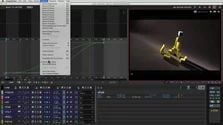

Lastly, it is good practice to save your work on an external hard drive as a backup.

You should choose these if you decide to bring the image sequence into another program for editing or manipulation. The green icon denotes where the high-quality images reside. Note that the images from the feed are low quality and shouldn’t really be used for further processes.

In these cases it will be imported to NOT work with compressed Quicktime videos.ĭragonframe sets up all your exposures as JPEGS and TIFFS.
Dragonframe onion skin pro#
Many of our projects will require using Image Sequences which be imported into Premiere Pro and compressed as video after editing and adding sound. Make a high-quality backup and a smaller version to upload to your Vimeo portfolio.
Dragonframe onion skin movie#
The movie type can be (H.264) or (Apple pro res 422 HQ).You can scale down even more for tests if you like. The scale should match your setup size, 1920 x 1080.The crop should be 16:9, push in mask as selected.The frame rate should match your playback speed (24fps).Examine settings and make sure you have the High Res source files selected.You can change the scale, output and frame rate in dialog box. Click and hold the High Res button on the keypad. It’s a good idea to check your High Res animation before you export to make sure it’s the same as what you’ve been previewing. When you have your piece edited as you want and are ready to export, you need to conform your master file to the EDL.įILE > Conform Current Take or press the CONFORM button to the left side of the frames. As you make edits while you’re working, DF4 creates an EDL (editing decision list) which hold all the changes you’ve made. Shoot your scene and playback (space bar or zero on the numeric keypad) to view your animation.īe sure to conform after making editing changes!Īll of your images are being saved in master folders behind the scenes. This is useful for setting up shots that must be perfectly aligned such as several passes on a single shot or under the camera/stop motion shot. This reveals the previous or next exposure in the timeline as an onion skin. Move it from center position to the right and left. In the ANIMATION window look at the controls under the window especially the red dot. This is the button which looks like a film strip.You can copy, paste, delete, etc. If all is good then you are ready to shoot your scene.Ĭlick back to the ANIMATION window and open up the timeline with thumbnails. Note: moving the lights and camera closer to subject can help with lighting but it can also cause washed out images and glare.Īdjust these until the artwork looks nice and take a test shot.
Dragonframe onion skin iso#
Begin the ISO at 200, the higher the number the grainier/noisy your shot will become. Go back and forth between settings to see how this changes the color temperature of your shot, this is a way to control cool or warm color tones. The camera settings are controlled in the camera control pane to the lower right of your screen. Focus by using the very bottom ring on the camera lens. It should magnify that area of the artwork. Drag it to a spot where you want to focus, then click. Now switch to the CINEMATOGRAPHY window (See workspace & Animation Tools Map (B) details at end of this sheet). The screen icon in the upper right corner denotes this window. You should now be able to see your art in the ANIMATION window.


 0 kommentar(er)
0 kommentar(er)
